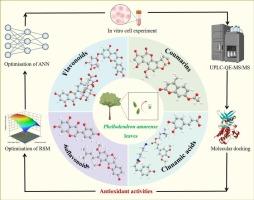超声辅助提取黄柏废叶中多酚的工艺优化及抗氧化性评价
IF 9.7
1区 化学
Q1 ACOUSTICS
引用次数: 0
摘要
食用和药用植物的生产产生了大量的生物质废弃物,这可能是生物活性化合物的丰富来源。本研究利用响应面法(RSM)和人工神经网络(ANN)对超声辅助提取法(UAE)对黄柏叶渣中多酚的提取工艺进行了优化。人工神经网络表现出优越的预测准确性。在超声时间为60 min,料液比为1:20 g/mL w/v,乙醇浓度为60%,超声功率为190 w的最佳条件下,总多酚得率最高,为28.66±0.07 mg GAE/g DW。所得提取物在细胞实验中显示出较强的抗氧化活性。采用液相色谱-质谱联用技术(LC-MS/MS)鉴定了木犀草素、异鼠李素和山奈酚等25种多酚类化合物,并进行了分子对接,预测了它们与胶原I (COL I)的相互作用可能是一种潜在的抗氧化机制。本研究结果支持了荷叶废弃物的增值利用,并为其在抗氧化保健品和植物性药物中的应用提供了基础。本文章由计算机程序翻译,如有差异,请以英文原文为准。

Optimization and antioxidant evaluation of clean and efficient recovery of polyphenols from Phellodendron amurense waste leaves via ultrasound-assisted extraction
The production of edible and medicinal plants results in significant biomass waste, which can be a rich source of bioactive compounds. This study optimized the extraction of polyphenols from Phellodendron amurense leaf waste using ultrasound-assisted extraction (UAE), with modeling via both response surface methodology (RSM) and artificial neural networks (ANN). ANN exhibited superior predictive accuracy. Under optimal UAE conditions (60 min ultrasonic time, 1:20 g/mL w/v solid-to-liquid ratio, 60 % v/v ethanol concentration, and 190 W ultrasonic power), the highest total polyphenol yield of 28.66 ± 0.07 mg GAE/g DW was achieved. The resulting extracts exhibited strong antioxidant activity in cellular assays. A total of 25 polyphenolic compounds, including luteolin, isorhamnetin, and kaempferol, were identified by liquid chromatography paired with mass spectrometry (LC-MS/MS), and molecular docking predicted their interaction with collagen I (COL I) as a potential antioxidant mechanism. These findings support the value-added utilization of P. amurense leaf waste and provide a foundation for its application in antioxidant nutraceuticals and plant-based pharmaceuticals.
求助全文
通过发布文献求助,成功后即可免费获取论文全文。
去求助
来源期刊

Ultrasonics Sonochemistry
化学-化学综合
CiteScore
15.80
自引率
11.90%
发文量
361
审稿时长
59 days
期刊介绍:
Ultrasonics Sonochemistry stands as a premier international journal dedicated to the publication of high-quality research articles primarily focusing on chemical reactions and reactors induced by ultrasonic waves, known as sonochemistry. Beyond chemical reactions, the journal also welcomes contributions related to cavitation-induced events and processing, including sonoluminescence, and the transformation of materials on chemical, physical, and biological levels.
Since its inception in 1994, Ultrasonics Sonochemistry has consistently maintained a top ranking in the "Acoustics" category, reflecting its esteemed reputation in the field. The journal publishes exceptional papers covering various areas of ultrasonics and sonochemistry. Its contributions are highly regarded by both academia and industry stakeholders, demonstrating its relevance and impact in advancing research and innovation.
 求助内容:
求助内容: 应助结果提醒方式:
应助结果提醒方式:


